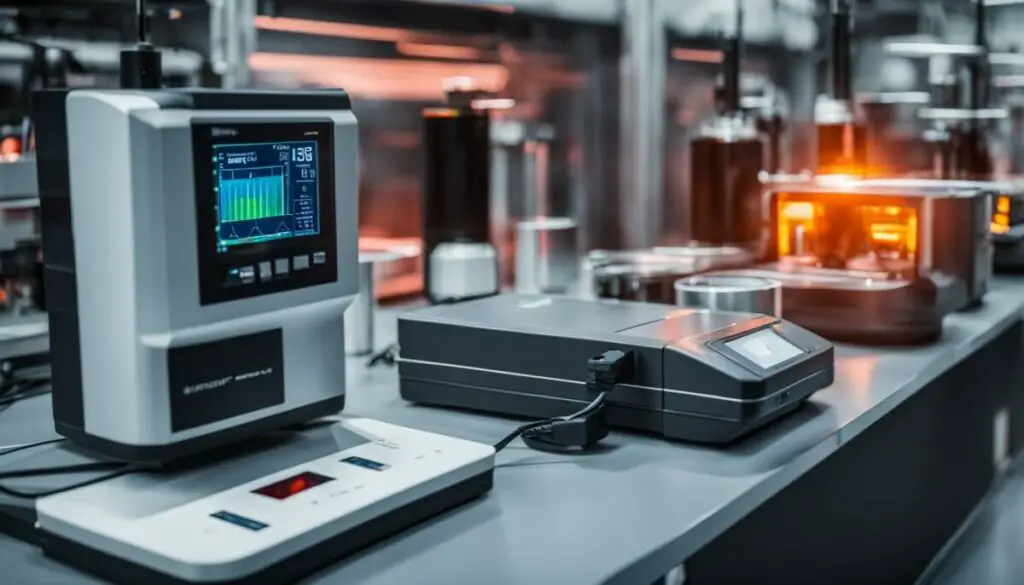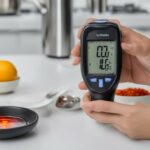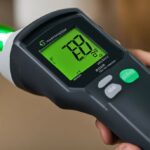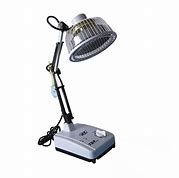Last Updated on 4 months by Francis
When it comes to infrared thermometers, one common question that arises is whether they are pre-calibrated or not. If you’re wondering about this too, you’ve come to the right place! In this article, we will delve into the world of infrared thermometers and shed light on their calibration process.
Let’s start by discussing the pre-calibrated infrared thermometers available in the market. One notable brand, Digi-Sense, offers an infrared Stick thermometer that is pre-calibrated and ready for immediate use. With features like a distance-to-target size ratio of 8:1, a temperature range of 0 to 575°F, and ±2% basic accuracy, this thermometer ensures accurate temperature readings right out of the box. To provide additional assurance, it also comes with a NIST-traceable certificate.
Contents
Key Takeaways:
- Some infrared thermometers are pre-calibrated and ready for immediate use.
- Digi-Sense offers a pre-calibrated infrared Stick thermometer with impressive features.
- The thermometer has a distance-to-target size ratio of 8:1 and a temperature range of 0 to 575°F.
- It provides ±2% basic accuracy and comes with a NIST-traceable certificate.
Benefits of Pre-Calibrated Infrared Thermometers
When it comes to temperature measurement, accuracy is of utmost importance. That’s why pre-calibrated infrared thermometers offer significant benefits to users in various industries and applications. Here are some advantages of using these factory-calibrated thermometers:
1. Time and Effort Savings: Pre-calibrated infrared thermometers are ready to use right out of the box. They are calibrated at the factory, ensuring accurate temperature readings without the need for additional calibration by the user. This saves valuable time and eliminates the hassle and potential errors associated with manual calibration.
2. Consistent Accuracy: Factory calibration ensures consistent accuracy across different units of the same model. This means that all thermometers of a specific model will provide reliable and precise measurements, allowing for consistent temperature monitoring in various settings.
3. Reliable Measurements: Pre-calibrated infrared thermometers undergo rigorous testing and quality control during manufacturing. As a result, users can trust that these thermometers provide reliable and trustworthy temperature readings. This is especially important in industries where precise measurements are crucial, such as food processing, HVAC, and medical applications.
4. User-Friendly: With pre-calibrated thermometers, there’s no need to worry about complex calibration procedures. Users can simply take the thermometer out of the box, point it at the target, and obtain accurate temperature readings. The simplicity and ease of use make pre-calibrated infrared thermometers ideal for both professionals and non-professionals alike.
5. Confidence and Peace of Mind: By using a pre-calibrated infrared thermometer, users can have confidence in the accuracy of their temperature measurements. They can trust that the thermometer has been calibrated according to industry standards and will provide reliable results. This peace of mind is invaluable, especially in critical applications where temperature control is essential.
6. Wide Range of Applications: Pre-calibrated infrared thermometers are versatile tools that can be used in various industries and applications. From HVAC maintenance and building inspections to food safety and automotive diagnostics, these thermometers offer a practical and efficient solution for temperature measurement needs.
To summarize, the benefits of pre-calibrated infrared thermometers include time and effort savings, consistent accuracy, reliable measurements, user-friendliness, confidence, and a wide range of applications. With these advantages, it’s no wonder why pre-calibrated infrared thermometers are a popular choice for professionals and individuals seeking accurate and hassle-free temperature measurements.
How to Calibrate Infrared Thermometers

While pre-calibrated infrared thermometers are ready to use, it is important to note that calibration may still be necessary in certain situations. Factors such as prolonged use, exposure to extreme temperatures, or physical damage can affect the accuracy of the thermometer and may require recalibration.
Calibration methods can vary depending on the specific model and brand, but generally involve comparing the readings of the thermometer to a known temperature source and adjusting the calibration accordingly. It is recommended to consult the manufacturer’s instructions or contact their customer support for specific calibration guidelines.
Here are the general steps to calibrate an infrared thermometer:
- Prepare the thermometer: Ensure that the thermometer is clean and free from any dirt or debris that may affect its readings.
- Select a reference temperature source: Choose a reliable and accurate temperature source, such as a calibrated contact thermometer or a calibrated blackbody device.
- Stabilize the reference temperature source: Allow the reference temperature source to stabilize at a known temperature before proceeding with the calibration process.
- Compare the thermometer readings: Point the infrared thermometer at the reference temperature source and compare the readings. Take multiple readings to ensure accuracy.
- Adjust the calibration: If there is a variance between the thermometer readings and the reference temperature, adjust the calibration settings as per the manufacturer’s instructions.
- Verify the calibration: After making the necessary adjustments, verify the calibration by comparing the thermometer readings to the reference temperature source again.
- Document the calibration: Record the calibration date, any adjustments made, and the verification results for future reference.
Remember, different thermometers may have specific calibration procedures, so it is crucial to follow the manufacturer’s guidelines. If you are unsure or have any questions, it is recommended to reach out to the manufacturer’s customer support for assistance.
Calibrating your infrared thermometer regularly ensures that it provides accurate and reliable temperature measurements, which is essential in various industries and applications.
| Benefits of Calibrating Infrared Thermometers |
|---|
| Increases the accuracy and reliability of temperature measurements |
| Ensures compliance with industry standards and regulations |
| Prevents potential risks and errors from inaccurate readings |
| Improves the performance and longevity of the infrared thermometer |
Importance of Calibrated Infrared Thermometers

Calibration is crucial for ensuring the accuracy of infrared thermometers. Inaccurate readings can lead to incorrect temperature measurements, which can have serious consequences in industries where temperature control is critical, such as food processing, HVAC, and medical applications. Regular calibration is necessary to maintain the reliability and consistency of the thermometer’s measurements.
Proper calibration is essential to ensure that the thermometer is providing accurate readings within an acceptable tolerance range. This is especially important in applications where precise temperature monitoring and control are vital for maintaining product quality, ensuring safety, and meeting regulatory requirements. With calibrated infrared thermometers, operators can trust the readings and make informed decisions based on accurate temperature data.
Calibrated infrared thermometers help to prevent potential issues that may arise from inaccurate measurements. In industries such as food processing, where temperature control is critical for ensuring food safety and preventing spoilage, using a calibrated thermometer is essential. Incorrect temperature measurements can lead to improperly cooked food or the growth of harmful bacteria, putting consumers’ health at risk and causing financial losses for businesses.
Furthermore, in industries like HVAC and medical applications, where precise temperature measurements are crucial for proper functioning and patient safety, calibration is of utmost importance. In HVAC systems, incorrect temperature readings can lead to inefficient operation, resulting in energy waste and decreased comfort levels. In medical applications, accurate temperature measurements are essential for diagnosis, treatment, and monitoring patients’ conditions.
Following the calibration requirements specified by the manufacturer is essential to ensure accurate and reliable temperature measurements. Manufacturers provide guidelines and procedures for performing calibration, which may involve comparing the readings of the thermometer to a known temperature source. Adhering to these requirements helps guarantee that the thermometer is providing accurate results in accordance with industry standards and regulations.
By recognizing the importance of calibrated infrared thermometers and adhering to proper calibration practices, industries and professionals can ensure the accuracy and reliability of temperature measurements. This enables them to maintain product quality, adhere to safety standards, and make informed decisions based on accurate temperature data.
Why Calibrated Infrared Thermometers are Essential:
- Ensure accuracy in temperature measurements
- Prevent risks and potential issues from inaccurate readings
- Meet regulatory requirements and industry standards
- Maintain product quality and safety
- Optimize HVAC systems’ efficiency
- Ensure patient safety in medical applications
Advantages of Pre-Calibrated Infrared Thermometers

Pre-calibrated infrared thermometers offer numerous advantages over their counterparts that require manual calibration. These benefits make them a popular choice in various industries and applications:
- Immediate Usability: One of the key advantages of pre-calibrated infrared thermometers is their out-of-the-box functionality. These thermometers are ready to use without any additional setup or calibration process. Users can start taking accurate temperature measurements right away, saving valuable time and ensuring efficient operations.
- Rigorous Testing and Quality Control: Pre-calibrated thermometers undergo extensive testing and quality control during the manufacturing process. This ensures that each unit meets standard accuracy requirements and provides reliable and consistent readings. Users can trust the quality and performance of these thermometers, especially in industries where precision and accuracy are crucial.
In summary, pre-calibrated infrared thermometers offer immediate usability and guarantee reliable and consistent measurements. Their convenience and accuracy make them highly valuable tools in a wide range of industries.
“Pre-calibrated infrared thermometers provide immediate usability and guarantee reliable and consistent measurements.”
Calibrating Infrared Thermometers for Accurate Readings

While pre-calibrated infrared thermometers are generally accurate, there are instances where recalibration may be necessary for achieving optimal accuracy. Regular calibration is recommended to ensure that the thermometer’s readings coincide with a known temperature source, providing precise and reliable measurements. Calibration should be performed at regular intervals or whenever there is a significant change in operating conditions or accuracy requirements. Following proper calibration procedures and guidelines is essential to achieve accurate readings and maintain the performance of the infrared thermometer.
To calibrate an infrared thermometer, it is important to follow the specific instructions provided by the manufacturer. The calibration process typically involves comparing the readings of the thermometer to a reference temperature source with a known value. This can be done using a calibrated blackbody device or a reference contact thermometer. By measuring the variance between the measured temperature and the reference temperature, the thermometer’s readings can be adjusted accordingly.
Regular calibration ensures that the infrared thermometer remains accurate and reliable over time. It helps to identify and correct any potential errors or discrepancies in temperature measurements, providing confidence in the results. Calibration should be conducted in accordance with industry standards and guidelines to ensure consistency and accuracy.
Benefits of Calibrating Infrared Thermometers
- Precise Measurements: Calibration allows the infrared thermometer to provide accurate and consistent temperature readings, ensuring reliable data.
- Compliance: Calibration ensures compliance with industry standards and regulations, particularly in fields where precise temperature control is critical.
- Quality Assurance: Regular calibration enhances quality control processes by verifying the accuracy and performance of the infrared thermometer.
- Longevity: Calibrating the thermometer helps extend its lifespan by identifying and addressing any issues that may affect its accuracy or functionality.
Factors to Consider in Infrared Thermometer Calibration
Calibration is a crucial step in ensuring accurate readings from infrared thermometers. To achieve precise results, it is essential to consider several factors during the calibration process. These factors include:
- The operating environment: The environment in which the thermometer is used can impact its accuracy. Factors such as humidity, air flow, and electromagnetic interference should be taken into account.
- The temperature range: Different thermometers have varying temperature ranges. It is important to calibrate the thermometer within the specified range to ensure accurate measurements.
- The emissivity settings: Emissivity refers to the ability of a surface to radiate heat. Infrared thermometers typically have adjustable emissivity settings to account for different materials. Setting the correct emissivity value is crucial for accurate temperature readings.
- The manufacturer’s calibration requirements: Each manufacturer provides specific guidelines for calibrating their infrared thermometers. It is vital to follow these requirements to ensure consistent and accurate readings.
To further enhance the accuracy of calibration, it is recommended to use a temperature reference source that is traceable to national or international standards. This ensures that the calibration is performed against a reliable and recognized standard, guaranteeing the reliability and accuracy of the infrared thermometer measurements.
By considering these factors and adhering to the manufacturer’s guidelines, you can calibrate your infrared thermometer effectively and obtain accurate temperature measurements.
The Process of Infrared Thermometer Calibration
The calibration process for infrared thermometers can vary depending on the model and brand. Generally, it involves comparing the thermometer’s readings to a reference temperature source with a known value. This is typically done using a calibrated blackbody device or a reference contact thermometer.
Once the readings are compared, any variance between the measured temperature and the reference temperature is taken into account. The thermometer’s readings are then adjusted accordingly to ensure accurate temperature measurements.
To properly calibrate an infrared thermometer, it is crucial to follow the specific instructions and guidelines provided by the manufacturer. These instructions will outline the necessary steps and procedures for the calibration process of the particular infrared thermometer being used.
By following the manufacturer’s guidelines, users can ensure that their infrared thermometers provide reliable and accurate temperature readings.
Conclusion
Infrared thermometers, whether pre-calibrated or requiring manual calibration, are essential tools for accurate temperature measurements in various industries and applications. The advantages of pre-calibrated infrared thermometers cannot be overlooked, as they offer immediate usability with accurate readings, saving time and effort for the users. However, it is important to note that recalibration may still be necessary in certain circumstances to maintain optimal accuracy.
Proper calibration procedures, adherence to manufacturer’s guidelines, and consideration of key factors such as temperature range and emissivity settings are crucial in achieving reliable and consistent measurements. Regular calibration helps ensure the accuracy and performance of your infrared thermometers, especially in industries where temperature control is critical, such as food processing, HVAC, and medical applications.
By understanding the importance of calibration and following the necessary procedures, users can maximize the benefits of their infrared thermometers. Whether it’s relying on the advantages of pre-calibrated thermometers or calibrating manually for accurate readings, prioritizing calibration enables users to maintain the precision and reliability necessary for their temperature measurement needs.
FAQ
Are infrared thermometers pre-calibrated?
Yes, many infrared thermometers are pre-calibrated at the factory for immediate use.
What are the benefits of pre-calibrated infrared thermometers?
Pre-calibrated infrared thermometers save time and effort for the user, providing accurate and reliable temperature readings right out of the box.
How do I calibrate infrared thermometers?
Calibration methods can vary, but generally involve comparing the thermometer’s readings to a known temperature source and adjusting accordingly. Consult the manufacturer’s instructions for specific guidelines.
Why is calibration important for infrared thermometers?
Calibration is crucial for ensuring accurate temperature measurements. Inaccurate readings can have serious consequences in industries where temperature control is critical.
What are the advantages of pre-calibrated infrared thermometers?
Pre-calibrated thermometers save time, provide immediate usability, and undergo rigorous testing during manufacturing for reliable and consistent readings.
How can I calibrate infrared thermometers for accurate readings?
Calibration requires considering factors such as the operating environment, temperature range, and emissivity settings. It is essential to follow the manufacturer’s guidelines and use a temperature reference source traceable to standards.
What are the requirements for infrared thermometer calibration?
Calibration requirements vary by manufacturer, but adherence to specific guidelines and industry standards is essential to maintain accuracy and reliability.
What is the process of calibrating an infrared thermometer?
The process typically involves comparing the thermometer’s readings to a reference temperature source with a known value and adjusting the calibration accordingly. Manufacturer’s instructions should be followed.
What is the importance of calibrated infrared thermometers?
Calibrated infrared thermometers ensure accurate temperature measurements, providing precision and reliability in various industries and applications.
Source Links
- https://www.southernlabware.com/infrared-stick-thermometer-8-1-with-nist-traceable-calibration.html
- https://preview.fishersci.com/shop/products/digi-sense-precalibrated-infrared-thermometers-3/13245267?tab=document
- https://us.vwr.com/store/product/23327576/digi-sense-pre-calibrated-professional-infrared-thermometers-cole-parmer









